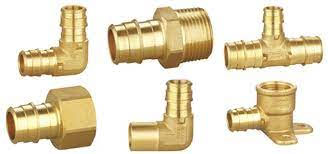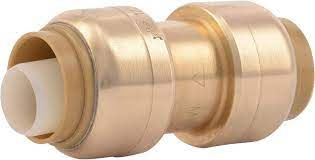The two most common types of PEX pipes are PEX-A and PEX-B. They are long-lasting, cheap, don’t corrode easily, and don’t suffer mineral build-up, as you would see in a copper pipe.
What is the difference between PEX-A vs PEX-B fittings? While there are several types of PEX fittings available, they are not all universal. For example, expansion fittings work great with PEX-A, but are incompatible with PEX-B. When comparing PEX-A vs PEX-B fittings, you must consider the properties of the pipes.
Keep reading to learn about the properties of PEX pipes and what fittings to use for each type of pipe.
Pex-A Vs Pex-B Fittings
Several types of fittings are used to connect PEX pipes. The table below shows the various types of fittings and their compatibility with PEX-A and PEX-B.
| Pex fitting type | Material | Compatibility | |
| Pex-A | Pex-B | ||
| Crimp | Polyester, brass | Yes | Yes |
| Expansion | Polyester, brass | Yes | No |
| Push | Polyester, brass | Yes | Yes |
| Press | Brass, polyester | Yes | Yes |

Crimp fittings are connected to PEX pipes using crimping tools. They have crimp rings that create a leak-proof connection between pipes once fastened.

Press fittings are similar to crimp fittings but don’t use crimp rings. Instead, the fitting is inserted into the pipe and compressed to secure the connection.

On the other hand, expansion fittings are used in plumbing systems that are expected to experience lots of thermal expansion and contraction.

Push fittings are designed to be installed easily by pushing the pipe in without special tools.
The type of fitting used for a PEX pipe depends on its properties. The sections below will explore PEX-A and PEX-B and help you compare the suitability of PEX-A vs PEX-B fittings for your project.
What Is Pex?
PEX, also known as cross-linked polyethylene, is a plastic material used to make pipes for residential water piping systems. Pipes made using PEX require fewer connections and fittings than most other pipes.
PEX-A
This form of PEX is made by crosslinking polyethylene using the ‘Engel’ process. This process involves adding peroxides to the high-density polyethylene (HDPE) before forming pipes, resulting in more atomic bonding. Hence, PEX-A has the most cross-linking of all PEX types.
Physical properties of PEX-A
The physical properties of PEX-A include the following:
- It has a density of about 0.9371 g/cm3
- PEX-A can handle temperatures ranging from -40°C to 95°C
- It has a high degree of elasticity, so it can undergo many freeze-and-thaw cycles without damage
- PEX-A is resistant to chemicals like chlorine
- Highly flexible
- It has high kink resistance
- Has a tensile strength of about 2000 psi
PEX-B
This type of PEX is by crosslinking polyethylene using the silane process, which involves curing the material with moisture. Unlike PEX-A, moisture curing is done after the polythene has been formed into a pipe.
Physical properties of PEX-B
Some physical properties of PEX-B include the following;
- It has a density of 0.951 g/cm3
- PEX-B is highly resistant to chemicals like chlorine
- Maximum operating temperature of 200°F (93°C) at 80 psi
- Maximum operating pressure of 160 psi at temperatures below 70°F
- Has a tensile strength of about 1000 psi
- It has low elasticity
- Low kink resistance
Pex-A Vs Pex-B Comparison
PEX-A and PEX-B fittings have many similar qualities as well as many differences. The table below shows a comparison of these pipes’ main attributes.
| Property | PEX-A | PEX-B |
| Kink resistance | Great | Poor |
| Kink healing | Excellent | Difficult |
| Flexibility | Flexible | Morely likely stiff |
| Density | Lower than PEX-B | High |
| Homogeneity | Good | Poor |
Similarities Between PEX-A and PEX-B
Both PEX-A and PEX-B are made with crosslinked polyethylene, so they have excellent resistance to many things, including heat, pressure, and chemicals. This ability to withstand various conditions means PEX-A and PEX-B are suitable for home plumbing and heating systems.
Additionally, PEX-A and PEX-B are durable, easy to use, and relatively high in tensile strength, making them the ideal fittings for many projects.
Differences between PEX-A and PEX-B
The differences between PEX-A and PEX-B primarily result from how they are manufactured. They include;
Tensile strength
PEX-A has higher tensile strength than PEX-B.
Homogeneity
PEX-A is made using the Engel process, resulting in more homogeneity and cross-linking throughout the pipe. This homogeneity results in a pipe that has consistent physical properties.
Meanwhile, PEX-B is made by curing polyethylene with moisture. PEX-B has less homogeneity and a wider range of properties than PEX-A.
Flexibility
PEX-A is more flexible, so it is suited to projects involving many turns and twists. Since PEX-A is flexible, inserting a PEX-A fitting is easy since the end can be fluted.
On the other hand, PEX-B is stiffer and more suited to projects that require long straight pipes.
Chlorine resistance
PEX-B can handle chlorine solutions for longer without deteriorating than PEX-A, which has lower chlorine resistance.
Installation
PEX-A is easy to install because of its flexibility and recovery from kinks. PEX-B, on the other hand, is less flexible, making it slightly more challenging to install in tight spaces with bends.
Recovery
PEX-A has excellent recovery from kinks and damage. When damaged or kinked, all you need to do is heat the bent area, which will return to its original shape. PEX-B has less recovery than PEX-A, so any kinks will probably lead to permanent damage.
Bursting strength
PEX-A has lower bursting strength, requiring a thicker pipe to withstand the same pressure levels as PEX-B.
Kink resistance
PEX-B fittings are more likely to be kinked than PEX-A fittings.
Cost
PEX-A pipes are the most expensive of all PEX pipes, while PEX-B is the cheapest.
When choosing PEX pipes for your plumbing project, you should consider each type’s properties and whether they suit your needs. Most PEX fittings are not universal since different pipes have different properties. So, you should ensure your fittings are the correct ones.
FAQs
Here are some answers to common questions about PEX fittings.
The choice of connection method depends on its cost and suitability to your project. That said, crimping is the most reliable way to connect pipes since the ring creates a long-lasting seal that is easy to install.
No, most PEX-A and PEX-B fittings are not interchangeable. Different PEX pipes have different physical properties, so choosing the correct fitting for the pipe you’re using in your plumbing system is vital.
Conclusion
The type of fittings you use for your plumbing project depends on the properties of the PEX pipes used. Hence, when comparing PEX-A vs PEX-B fittings, you should consider the pipes’ physical properties.
Crimp, push-fit, and press fittings work great for PEX-A and PEX-B because they do not depend on a pipe’s ability to expand or recover. Expansion fittings, however, are not great for PEX-B because its ability to expand and a contract is limited.